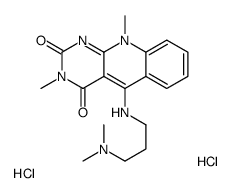HLI 373
Modify Date: 2024-03-07 17:52:08

HLI 373 structure
|
Common Name | HLI 373 | ||
|---|---|---|---|---|
| CAS Number | 502137-98-6 | Molecular Weight | 414.32900 | |
| Density | N/A | Boiling Point | N/A | |
| Molecular Formula | C18H23N5O2 | Melting Point | N/A | |
| MSDS | N/A | Flash Point | N/A | |
Use of HLI 373HLI373 is an efficacious Hdm2 inhibitor. HLI373 inhibits the ubiquitin ligase activity of Hdm2. HLI373 is effective in inducing apoptosis of several tumor cells that are sensitive to DNA-damaging agents[1]. Antimalarial activity[2]. |
| Name | 5-{[3-(Dimethylamino)propyl]amino}-3,10-dimethylpyrimido[4,5-b]qu inoline-2,4(3H,10H)-dione dihydrochloride |
|---|---|
| Synonym | More Synonyms |
| Description | HLI373 is an efficacious Hdm2 inhibitor. HLI373 inhibits the ubiquitin ligase activity of Hdm2. HLI373 is effective in inducing apoptosis of several tumor cells that are sensitive to DNA-damaging agents[1]. Antimalarial activity[2]. |
|---|---|
| Related Catalog | |
| Target |
Hdm2[1]; Apoptosis[1]; Antimalarial[2] |
| In Vitro | HLI373 (3-15 μM; 15 hours) selectively kills tumor cells harboring wild type p53[1]. HLI373 (10-50 μM) stabilizes cellular Hdm2 in a dose-dependent manner. HLI373 (3 μM) activates p53 transcription[1]. HLI373 selectively inhibits auto-ubiquitylation of Hdm2[1]. Co-transfection with plasmids encoding p53 and Hdm2 results in degradation of p53. Incubation with HLI373 (5-10 μM; 8 hours) blocks p53 degradation. HLI373 increases p53 and Hdm2 protein levels in cells[1]. HLI 373 also shows lower IC50 values (below 6 μM) against both chloroquine-sensitive P. falciparum D6 strain (PfD6) and chloroquine-resistant P. falciparum W2 strain (PfW2) and exhibits early growth inhibition[2]. HLI-373 is a MDM2 inhibitor interrupting its ubiquitin E3 ligase activity, could abolish the ubiquitylation of its substrate protein p53. HLI-373 targets the C-terminus functioning as an E3 ubiquitin ligase[3]. Cell Viability Assay[1] Cell Line: Wild type p53 mouse embryo fibroblasts (MEFs), and p53-deficient MEFs Concentration: 3, 10, 15 μM Incubation Time: 15 hours Result: Increased cell death in wild type p53 MEFs in a dose-dependent manner, p53-deficient MEFs were relatively resistant. Western Blot Analysis[1] Cell Line: U2OS cells Concentration: 5, 10 μM Incubation Time: 8 hours Result: Blocked p53 degradation caused by co-transfection with plasmids encoding p53 and Hdm2. |
| References |
| Molecular Formula | C18H23N5O2 |
|---|---|
| Molecular Weight | 414.32900 |
| Exact Mass | 413.13900 |
| PSA | 72.16000 |
| LogP | 2.82600 |
| Hazard Codes | Xi |
|---|
| MFCD30543744 |